2018 HONDA CLARITY PLUG IN HYBRID brakes
[x] Cancel search: brakesPage 17 of 591
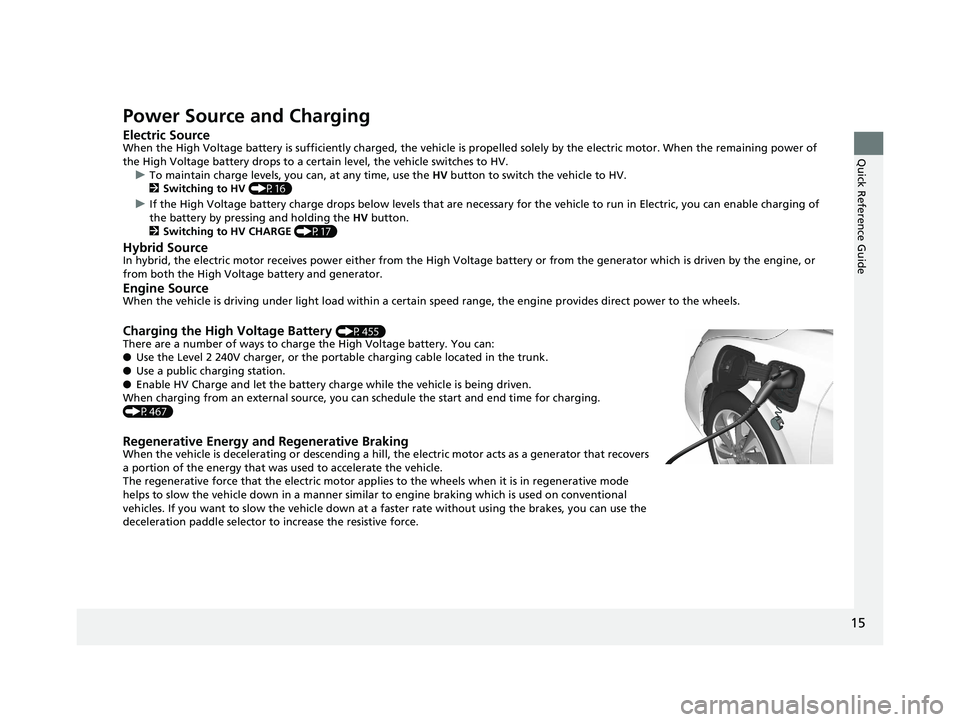
15
Quick Reference Guide
Power Source and Charging Electric Source When the High Voltage battery is sufficiently charged, the vehicl e is propelled solely by the electric motor. When the remainin g power of
the High Voltage battery drops to a certain level, the vehicle switches to HV.
u To maintain charge levels, you can, at any time, use the HV button to switch the vehicle to HV.
2 Switching to HV (P16)
u If the High Voltage battery charge drops below levels that are necessary for the vehicle to run in Electric, you can enable cha rging of
the battery by pressing and holding the HV button.
2 Switching to HV CHARGE (P17)
Hybrid Source In hybrid, the electric motor receives powe r either from the High Voltage battery or from the generator which is driven by the engine, or
from both the High Volt age battery and generator.
Engine Source When the vehicle is driving under light load within a certain speed range, the engine provides direct power to the wheels.
Charging the High Voltage Battery (P455)
There are a number of ways to charge the High Voltage battery. You can:
● Use the Level 2 240V charger, or the portable charging cable located in the trunk.
● Use a public charging station.
● Enable HV Charge and let the battery charge while the vehicle is being driven.
When charging from an external source, you ca n schedule the start and end time for charging.
(P467)
Regenerative Energy and Regenerative Braking When the vehicle is decelerating or descending a hill, the electric motor acts as a generator that recovers
a portion of the energy that was used to accelerate the vehicle.
The regenerative force that the electric motor applie s to the wheels when it is in regenerative mode
helps to slow the vehicle down in a manner similar to engine braking which is used on conventional
vehicles. If you want to slow the vehicle down at a faster rate without using the brakes, you can use the
deceleration paddle selector to increase the resistive force. 18 CLARITY PHEV CSS-31TRW6000.book 15 ページ 2017年8月31日 木曜日 午後2時 49分
Page 39 of 591
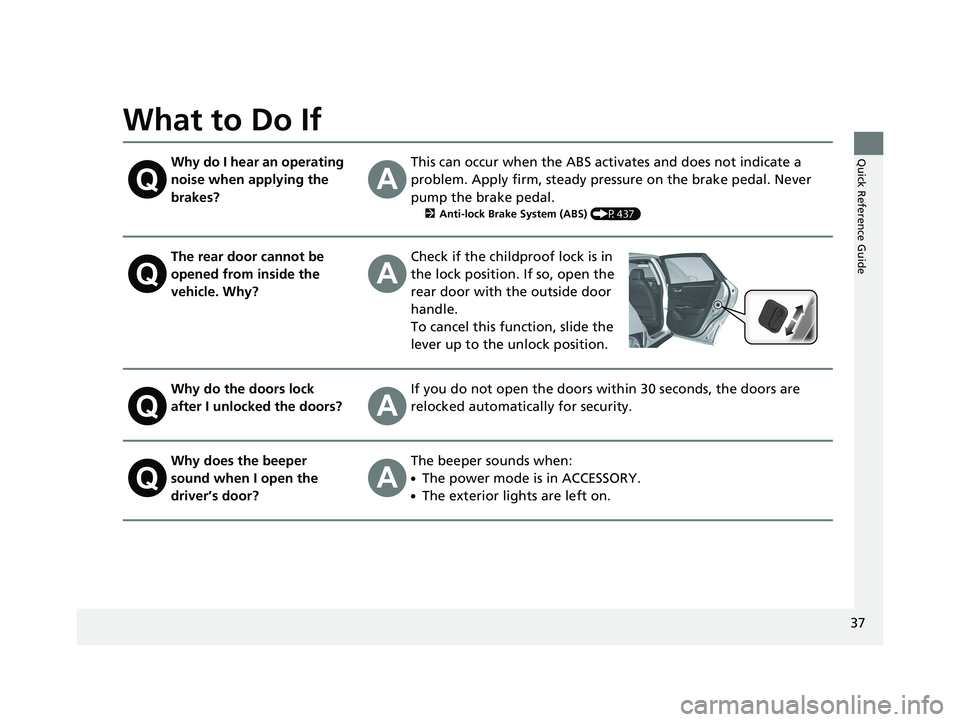
37
Quick Reference Guide
What to Do If Why do I hear an operating
noise when applying the
brakes? This can occur when the ABS activates and does not indicate a
problem. Apply firm, steady pressure on the brake pedal. Never
pump the brake pedal. 2 Anti-lock Brake System (ABS) (P437)
The rear door cannot be
opened from inside the
vehicle. Why? Check if the childproof lock is in
the lock position. If so, open the
rear door with the outside door
handle.
To cancel this function, slide the
lever up to the unlock position.
Why do the doors lock
after I unlocked the doors? If you do not open the doors within 30 seconds, the doors are
relocked automatically for security.
Why does the beeper
sound when I open the
driver’s door? The beeper sounds when: ●
The power mode is in ACCESSORY. ●
The exterior lights are left on.18 CLARITY PHEV CSS-31TRW6000.book 37 ページ 2017年8月31日 木曜日 午後2時 49分
Page 117 of 591
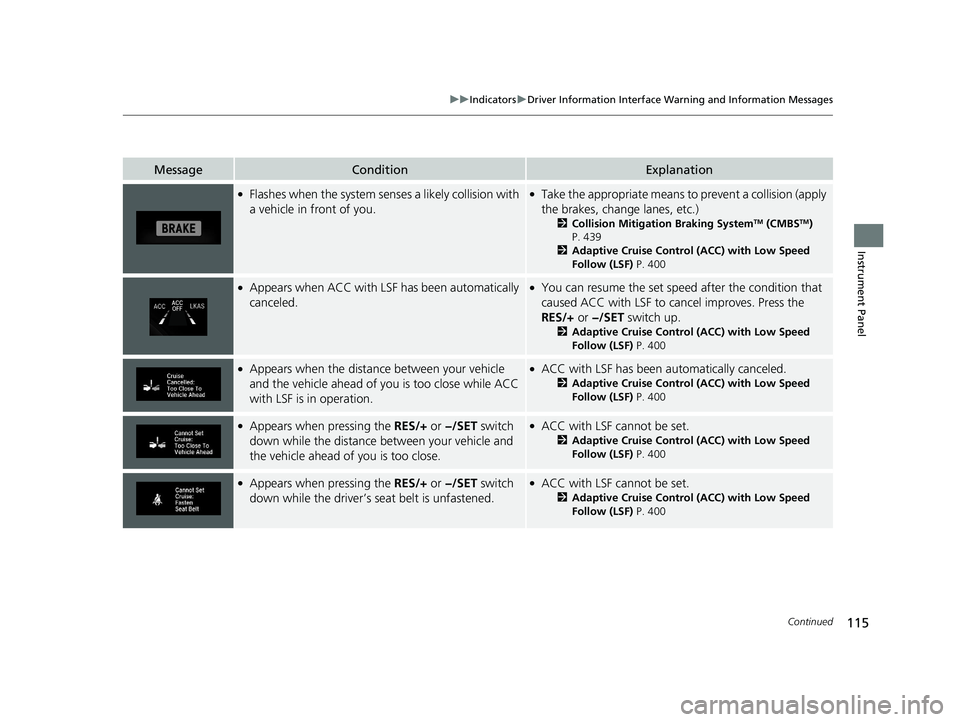
115uu Indicators u Driver Information Interface Wa rning and Information Messages
Continued
Instrument Panel
Message Condition Explanation●
Flashes when the system senses a likely collision with
a vehicle in front of you. ●
Take the appropriate means to prevent a collision (apply
the brakes, change lanes, etc.) 2 Collision Mitigation Braking System TM
(CMBS TM
)
P. 439
2 Adaptive Cruise Control (ACC) with Low Speed
Follow (LSF) P. 400●
Appears when ACC with LSF has been automatically
canceled. ●
You can resume the set speed after the condition that
caused ACC with LSF to cancel improves. Press the
RES/+ or −/SET switch up. 2 Adaptive Cruise Control (ACC) with Low Speed
Follow (LSF) P. 400●
Appears when the distance between your vehicle
and the vehicle ahead of you is too close while ACC
with LSF is in operation. ●
ACC with LSF has been automatically canceled. 2 Adaptive Cruise Control (ACC) with Low Speed
Follow (LSF) P. 400●
Appears when pressing the RES/+ or −/SET switch
down while the distance between your vehicle and
the vehicle ahead of you is too close. ●
ACC with LSF cannot be set. 2 Adaptive Cruise Control (ACC) with Low Speed
Follow (LSF) P. 400●
Appears when pressing the RES/+ or −/SET switch
down while the driver’s seat belt is unfastened. ●
ACC with LSF cannot be set. 2 Adaptive Cruise Control (ACC) with Low Speed
Follow (LSF) P. 40018 CLARITY PHEV CSS-31TRW6000.book 115 ページ 2017年8月31日 木曜日 午後2時49分
Page 402 of 591
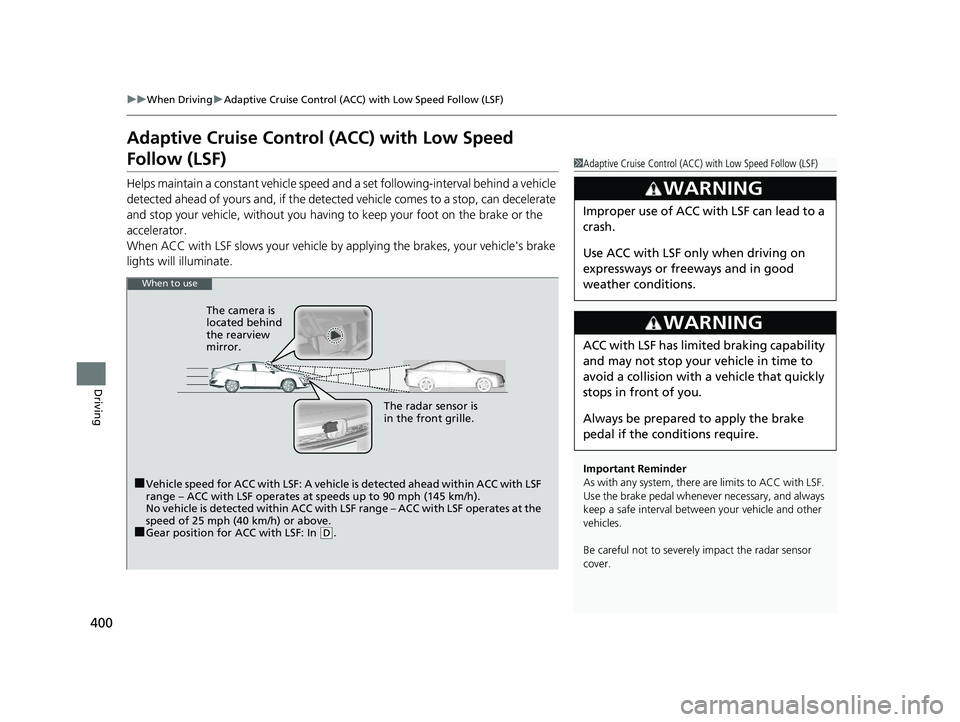
400 uu When Driving u Adaptive Cruise Control (ACC) with Low Speed Follow (LSF)
Driving Adaptive Cruise Control (ACC) with Low Speed
Follow (LSF) Helps maintain a constant vehicle speed an d a set following-interval behind a vehicle
detected ahead of yours and, if the detect ed vehicle comes to a stop, can decelerate
and stop your vehicle, without you having to keep your foot on the brake or the
accelerator.
When ACC with LSF slows your vehicle by applying the brakes, your vehicle's brake
lights will illuminate. 1 Adaptive Cruise Control (ACC) with Low Speed Follow (LSF)
Important Reminder
As with any system, there are limits to ACC with LSF.
Use the brake pedal whenever necessary, and always
keep a safe interval betw een your vehicle and other
vehicles.
Be careful not to severely impact the radar sensor
cover.3
WARNING Improper use of ACC wi th LSF can lead to a
crash.
Use ACC with LSF only when driving on
expressways or freeways and in good
weather conditions.
3
WARNING ACC with LSF has limite d braking capability
and may not stop your vehicle in time to
avoid a collision with a vehicle that quickly
stops in front of you.
Always be prepared to apply the brake
pedal if the conditions require.When to use
■ Vehicle speed for ACC with LSF: A vehicle is detected ahead within ACC with LSF
range – ACC with LSF operates at speeds up to 90 mph (145 km/h).
No vehicle is detected within ACC with LSF range – ACC with LSF operates at the
speed of 25 mph (40 km/h) or above.
■ Gear position for ACC with LSF: In ( D
. The radar sensor is
in the front grille.The camera is
located behind
the rearview
mirror.18 CLARITY PHEV CSS-31TRW6000.book 400 ページ 2017年8月31日 木曜日 午後2時49分
Page 403 of 591
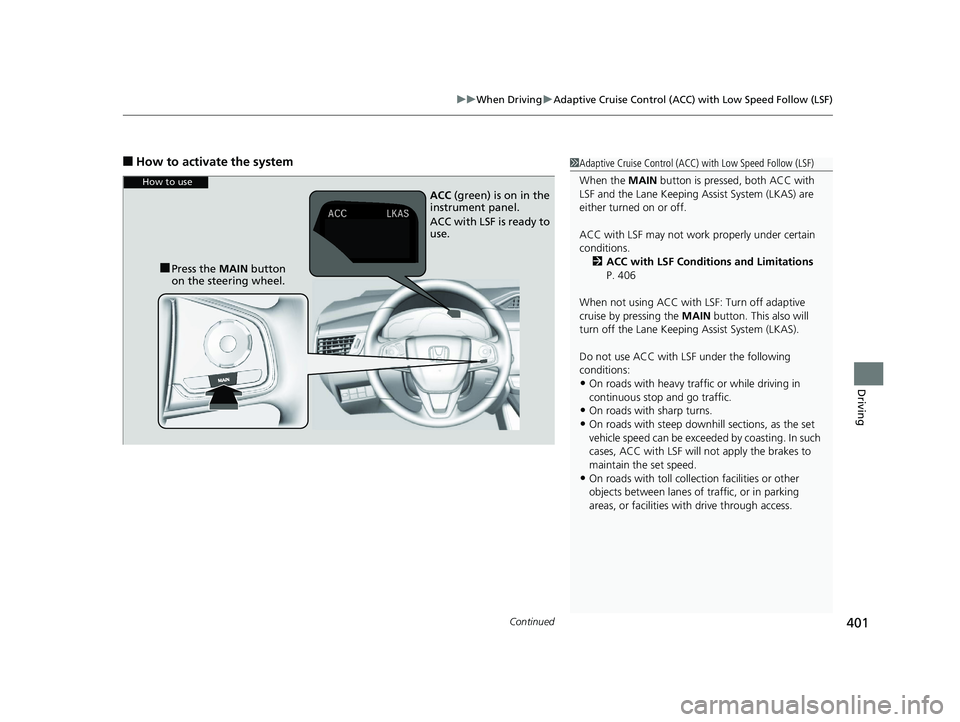
Continued
401uu When Driving u Adaptive Cruise Control (ACC) with Low Speed Follow (LSF)
Driving
■ How to activate the system 1 Adaptive Cruise Control (ACC) with Low Speed Follow (LSF)
When the MAIN button is pressed, both ACC with
LSF and the Lane Keeping A ssist System (LKAS) are
either turned on or off.
ACC with LSF may not work properly under certain
conditions.
2 ACC with LSF Conditions and Limitations
P. 406
When not using ACC with LSF: Turn off adaptive
cruise by pressing the MAIN button. This also will
turn off the Lane Keeping Assist System (LKAS).
Do not use ACC with LSF under the following
conditions:
• On roads with heavy traf fic or while driving in
continuous stop and go traffic.
• On roads with sharp turns.
• On roads with steep downhill sections, as the set
vehicle speed can be exceeded by coasting. In such
cases, ACC with LSF will not apply the brakes to
maintain the set speed.
• On roads with toll collection facilities or other
objects between lanes of traffic, or in parking
areas, or faci lities with driv e through access.How to use
■ Press the MAIN button
on the steering wheel. ACC (green) is on in the
instrument panel.
ACC with LSF is ready to
use.18 CLARITY PHEV CSS-31TRW6000.book 401 ページ 2017年8月31日 木曜日 午後2時49分
Page 407 of 591
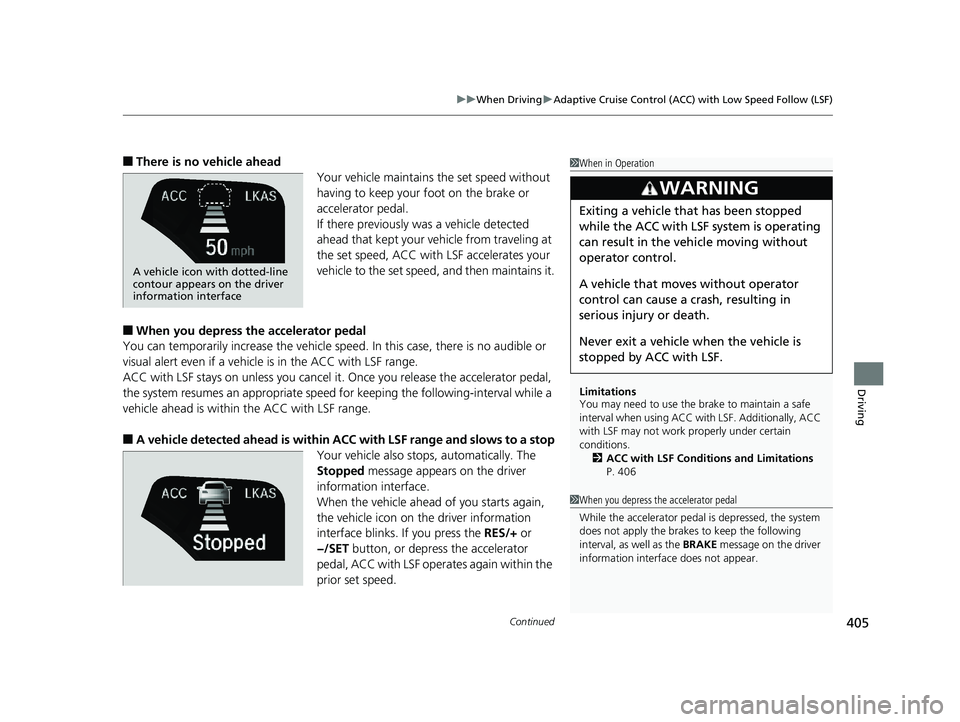
Continued
405uu When Driving u Adaptive Cruise Control (ACC) with Low Speed Follow (LSF)
Driving
■ There is no vehicle ahead
Your vehicle maintains the set speed without
having to keep your foot on the brake or
accelerator pedal.
If there previously was a vehicle detected
ahead that kept your ve hicle from traveling at
the set speed, ACC with LSF accelerates your
vehicle to the set speed, and then maintains it.
■ When you depress the accelerator pedal
You can temporarily increase the vehicle speed . In this case, there is no audible or
visual alert even if a vehicl e is in the ACC with LSF range.
ACC with LSF stays on unless you cancel it . Once you release th e accelerator pedal,
the system resumes an appropriate speed fo r keeping the followi ng-interval while a
vehicle ahead is within the ACC with LSF range.
■ A vehicle detected ahead is within ACC with LSF range and slows to a stop
Your vehicle also stops, automatically. The
Stopped message appears on the driver
information interface.
When the vehicle ahead of you starts again,
the vehicle icon on the driver information
interface blinks. If you press the RES/+ or
−/SET button, or depress the accelerator
pedal, ACC with LSF operates again within the
prior set speed. 1 When in Operation
Limitations
You may need to use the brake to maintain a safe
interval when using ACC wi th LSF. Additionally, ACC
with LSF may not work properly under certain
conditions.
2 ACC with LSF Conditions and Limitations
P. 4063
WARNING Exiting a vehicle that has been stopped
while the ACC with LSF system is operating
can result in the ve hicle moving without
operator control.
A vehicle that moves without operator
control can cause a crash, resulting in
serious injury or death.
Never exit a vehicle when the vehicle is
stopped by ACC with LSF.A vehicle icon with dotted-line
contour appears on the driver
information interface
1 When you depress the accelerator pedal
While the accelerator pedal is depressed, the system
does not apply the brakes to keep the following
interval, as well as the BRAKE message on the driver
information interface does not appear.18 CLARITY PHEV CSS-31TRW6000.book 405 ページ 2017年8月31日 木曜日 午後2時49分
Page 409 of 591
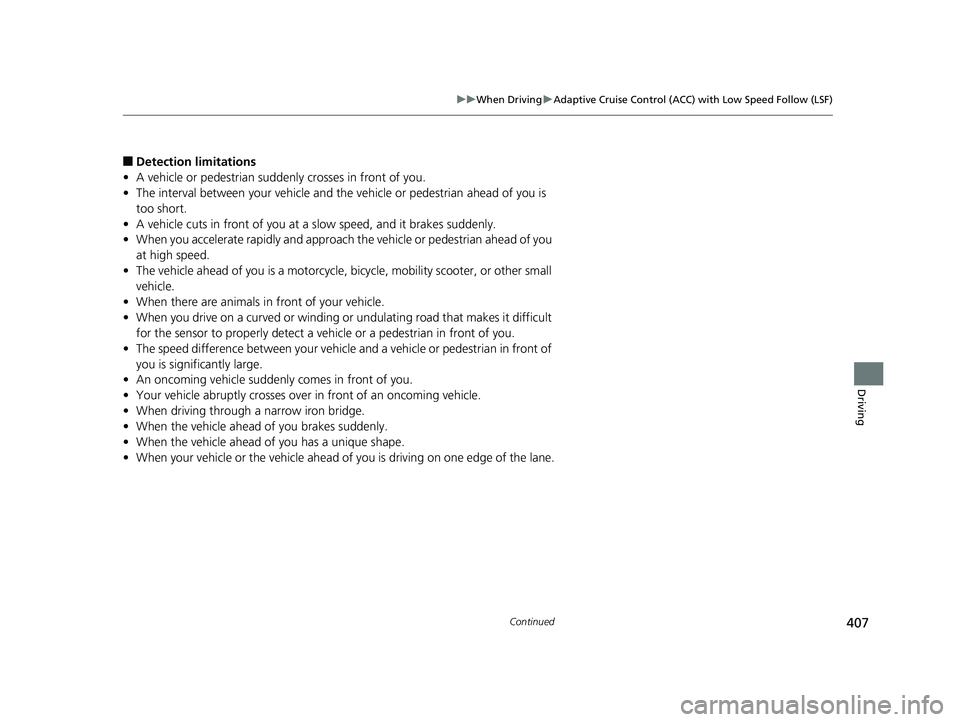
407uu When Driving u Adaptive Cruise Control (ACC) with Low Speed Follow (LSF)
Continued
Driving
■ Detection limitations
• A vehicle or pedestrian suddenly crosses in front of you.
• The interval between your vehicle and the vehicle or pedestrian ahead of you is
too short.
• A vehicle cuts in front of you at a slow speed, and it brakes suddenly.
• When you accelerate rapidly and approach the vehicle or pedestrian ahead of you
at high speed.
• The vehicle ahead of you is a motorcycle, bicycle, mobility scooter, or other small
vehicle.
• When there are animals in front of your vehicle.
• When you drive on a curved or winding or undulating road that makes it difficult
for the sensor to properly detect a vehicle or a pedestrian in front of you.
• The speed difference between your vehicle an d a vehicle or pedestrian in front of
you is significantly large.
• An oncoming vehicle suddenly comes in front of you.
• Your vehicle abruptly crosses over in front of an oncoming vehicle.
• When driving through a narrow iron bridge.
• When the vehicle ahead of you brakes suddenly.
• When the vehicle ahead of you has a unique shape.
• When your vehicle or the vehicle ahead of you is driving on one edge of the lane. 18 CLARITY PHEV CSS-31TRW6000.book 407 ページ 2017年8月31日 木曜日 午後2時49分
Page 414 of 591
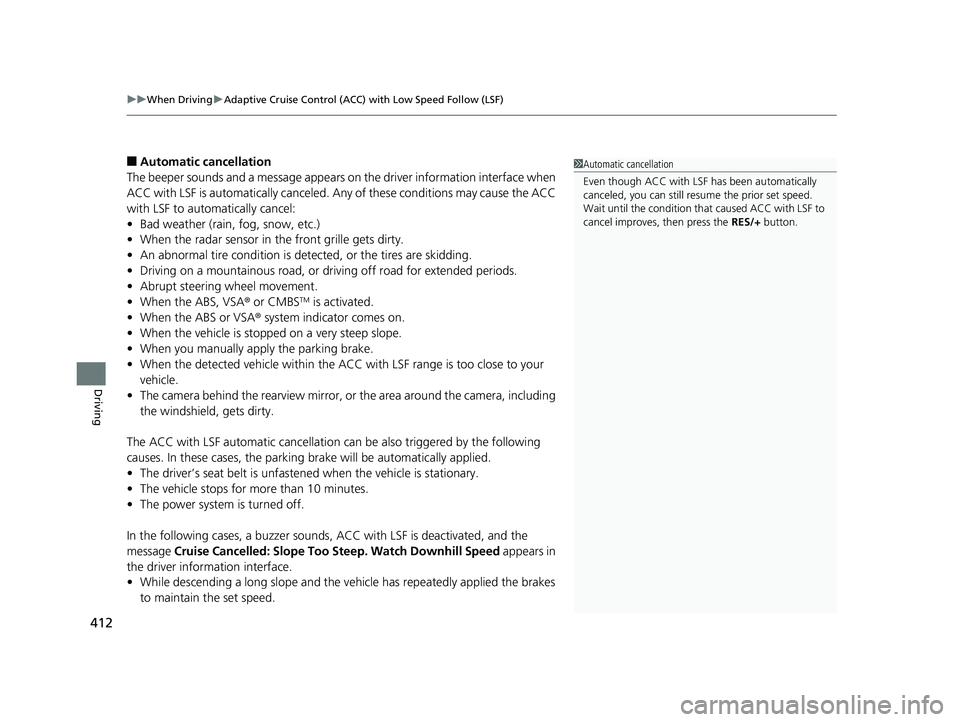
uu When Driving u Adaptive Cruise Control (ACC) with Low Speed Follow (LSF)
412
Driving ■ Automatic cancellation
The beeper sounds and a message appears on the driver information interface when
ACC with LSF is automatically canceled. An y of these conditions may cause the ACC
with LSF to automatically cancel:
• Bad weather (rain, fog, snow, etc.)
• When the radar sensor in the front grille gets dirty.
• An abnormal tire condition is detected, or the tires are skidding.
• Driving on a mountainous road, or driving off road for extended periods.
• Abrupt steering wheel movement.
• When the ABS, VSA ® or CMBS TM
is activated.
• When the ABS or VSA ® system indicator comes on.
• When the vehicle is stopped on a very steep slope.
• When you manually apply the parking brake.
• When the detected vehicle within the ACC with LSF range is too close to your
vehicle.
• The camera behind the rearview mirror, or the area around the camera, including
the windshield, gets dirty.
The ACC with LSF automatic cancellation can be also triggered by the following
causes. In these cases, the parking brake will be automatically applied.
• The driver’s seat belt is unfasten ed when the vehicl e is stationary.
• The vehicle stops for mo re than 10 minutes.
• The power system is turned off.
In the following cases, a buzzer sounds, ACC with LSF is deactivated, and the
message Cruise Cancelled: Slope Too Steep. Watch Downhill Speed appears in
the driver information interface.
• While descending a long slope and the vehi cle has repeatedly applied the brakes
to maintain the set speed. 1 Automatic cancellation
Even though ACC with LSF has been automatically
canceled, you can still resu me the prior set speed.
Wait until the condition that caused ACC with LSF to
cancel improves, then press the RES/+ button.18 CLARITY PHEV CSS-31TRW6000.book 412 ページ 2017年8月31日 木曜日 午後2時49分